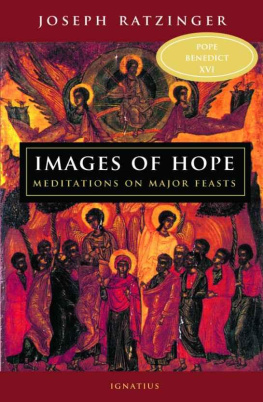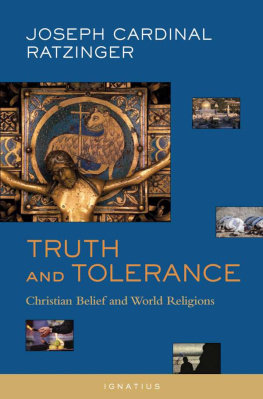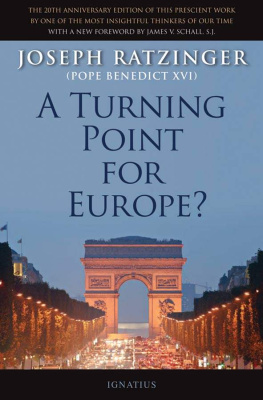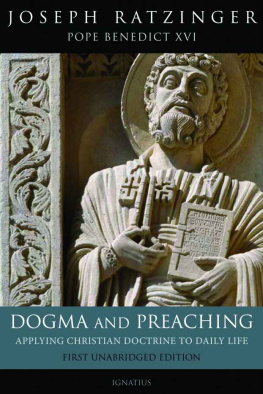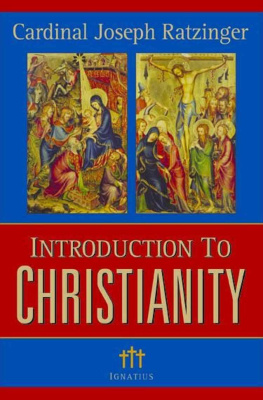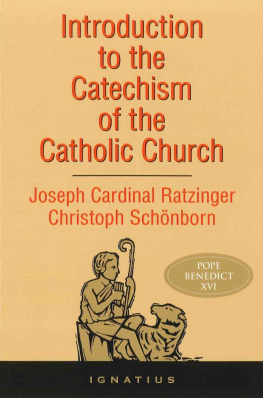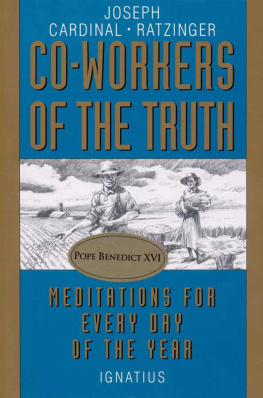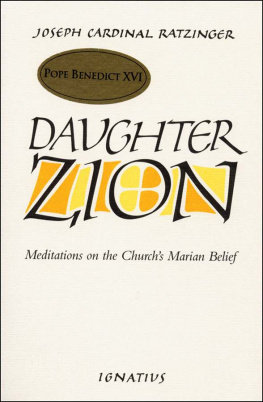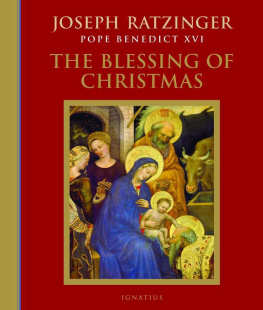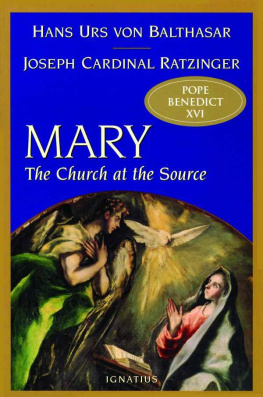Joseph Cardinal Ratzinger - Images of Hope: Meditations on Major Feasts
Here you can read online Joseph Cardinal Ratzinger - Images of Hope: Meditations on Major Feasts full text of the book (entire story) in english for free. Download pdf and epub, get meaning, cover and reviews about this ebook. year: 0, genre: Religion. Description of the work, (preface) as well as reviews are available. Best literature library LitArk.com created for fans of good reading and offers a wide selection of genres:
Romance novel
Science fiction
Adventure
Detective
Science
History
Home and family
Prose
Art
Politics
Computer
Non-fiction
Religion
Business
Children
Humor
Choose a favorite category and find really read worthwhile books. Enjoy immersion in the world of imagination, feel the emotions of the characters or learn something new for yourself, make an fascinating discovery.
- Book:Images of Hope: Meditations on Major Feasts
- Author:
- Genre:
- Year:0
- Rating:4 / 5
- Favourites:Add to favourites
- Your mark:
- 80
- 1
- 2
- 3
- 4
- 5
Images of Hope: Meditations on Major Feasts: summary, description and annotation
We offer to read an annotation, description, summary or preface (depends on what the author of the book "Images of Hope: Meditations on Major Feasts" wrote himself). If you haven't found the necessary information about the book — write in the comments, we will try to find it.
Joseph Cardinal Ratzinger: author's other books
Who wrote Images of Hope: Meditations on Major Feasts? Find out the surname, the name of the author of the book and a list of all author's works by series.
Images of Hope: Meditations on Major Feasts — read online for free the complete book (whole text) full work
Below is the text of the book, divided by pages. System saving the place of the last page read, allows you to conveniently read the book "Images of Hope: Meditations on Major Feasts" online for free, without having to search again every time where you left off. Put a bookmark, and you can go to the page where you finished reading at any time.
Font size:
Interval:
Bookmark:
Images of Hope
JOSEPH CARDINAL RATZINGER
(POPE BENEDICT XVI)
Images of Hope
Ventures into the Churchs Year
Translated by Father John Rock, S.J.
IGNATIUS PRESS SAN FRANCISCO
Title of the German original: Bilder der Hoffnung
1997, 2006 by Verlag Herder, Freiburg im Breisgau
With special acknowledgment to Sister Mary Pius, O.P.,
for her contribution to Father Rocks translation.
Cover art: Ascension
Cover design by Roxanne Mei Lum
Photograph of the Chair Altar of Saint Peters in Rome
by Mary Gibson
2006 Libreria Editrice Vaticana
2006 by Ignatius Press, San Francisco
All rights reserved
ISBN 978-0-89870-964-3 (HB)
Library of Congress Control Number 2006922685
Contents
Ox and Ass at the Crib
The Message of the Basilica of Saint Mary Major in Rome
The Warrior and the Sufferer
Primacy in Love
The Chair Altar of Saint Peters in Rome
I Do Indeed Hear the Message...
Sarahs Laughter, translated by Graham Harrison
The Beginning of a New Year
The Holy Spirit and the Church
The Mosaics in the Apse of Saint Clements Basilica in Rome
What Indulgence Means
A European Saint
At the Feet of Saint Peters Basilica
Sites of HopeThe Roman Catacombs
Foreword
In the course of my years in Rome, I was invited again and again by Bavarian Radio to give meditations on the high points of the liturgical year. Frequently, too, I was encouraged to interpret one of the great images that are so abundant in the churches of Rome. At the approach of my seventieth birthday, my brother suggested I collect these texts and see whether they might not produce a small volume that could preserve the interwoven images and thoughts beyond their airing on radio or television and thereby be of help in understanding the Christian feasts. The plan was discussed with Bavarian Radios advisor on Church matters, Prelate Willibald Leierseder, who had initiated most of the meditations and had selected the corresponding images, as well as with Herder publishers. So that is how this small volume originated. It is, certainly, not free of coincidental elements, but it can perhaps help us nevertheless to hear that message of hope again more clearly and to renew that inner gaze which is so often overwhelmed by the flood of images and offers that assails us.
I thank my brother, especially, Cathedral Choir Director Georg Ratzinger, without whose insistent encouragement I would not have taken up this project. I thank also Prelate Leierseder and the people at Bavarian Radio, who assigned the themes and images. I thank Verlag Herder, which exercised great care to ensure that readers might take up this little book with joy.

ANNUNCIATION
Mosaic from the Triumphal Arch
of Saint Mary Major Basilica, Rome

Ox and Ass at the Crib.
Detail of the Hadamar Manger, by Helmut Piccolruaz
Christmas
______
Ox and Ass at the Crib
Despite all the hustle and bustle at Christmas, we fervently desire that this festive time will grant us opportunity for reflection, joy, and contact with the goodness of our God and will accordingly renew our resolve to persevere. Before we reflect on what this feast can say to us today, a brief look at the origin of the celebration of Christmas might prove helpful.
The Churchs year of feasts first developed, not with a view to the birth of Christ, but from faith in his Resurrection. Thus the original feast of Christianity is Easter, not Christmas. For indeed it was the Resurrection that established Christian faith and let the Church come to be. For this reason, Ignatius of Antioch (who died at the latest in A.D. 117) already called Christians those who no longer keep the Sabbath but rather live according to the Lords Day. Being a Christian means living from Easter, that is, from the Resurrection that is celebrated every week on Sunday. It was Hippolytus who first established with certainty, in his commentary on Daniel, written about A.D. 204, that Jesus was born on December 25. Bo Reicke, the early exegete from Basel, pointed moreover to the calendar of feasts, according to which, in Lukes Gospel, the accounts of the birth of the Baptist and the birth of Jesus are related to each other. It would follow from this that Luke in his Gospel presupposes December 25 as Jesus day of birth. On that day, the feast of the Dedication of the Temple, introduced by Judas Maccabeus in 164 B.C., was celebrated. At the same time, the date of Jesus birth was symbolized, so that with him, who arose as Gods light in the winter night, the true dedication of the Templethe arrival of God in the midst of the worldmight take place.
Be that as it may, the feast of Christmas did not assume clear contours in Christendom until the fourth century, when it displaced the Roman feast of the unconquered sun-god. Christs birth became understood as the victory of the true light. Bo Reicke has clearly shown in his notes that an already old Judeo-Christian tradition was contained in this recasting of a pagan celebration into a Christian solemnity.
The special human warmth we feel at Christmas, which has significantly overtaken that of Easter in the hearts of Christians, did not develop until the Middle Ages. It was Francis of Assisi who helped bring this novelty about through his deep love for the man Jesus, for the God with us. As his first biographer, Thomas of Celano, explains in his second description of Francis life: He celebrated Christmas more than any other feast with an indescribable joy. He said that this was the feast of feasts, for on this day God became a small child and sucked milk like all children of men. Francis embraced with great affection and devotion the images that represented the child Jesus and stammered words of sympathy as children do words of affection. The name of Jesus was sweet as honey on his lips.
It was such a disposition that gave rise to the famous celebration of Christmas in Greccio. His visits to the Holy Land and to the manger in Saint Mary Major may have inspired him here. What moved him was the longing for nearness, for reality. He wanted to experience Bethlehem directly. He wanted to experience up close the birth of the child Jesus and to tell all his friends.
Celano recounts the night at the crib in the first biography in a way that is moving and that at the same time has decidedly contributed to the development of the most beautiful custom of the crche. We can therefore justifiably say that the night at Greccio gave Christendom the festival of Christmas again in a brand new way. Accordingly, its own expression, its special warmth and humanity, the humanity of our God, communicated themselves to souls, giving faith a new dimension. The feast of the Resurrection had directed ones gaze to Gods power, which overcomes death and teaches us to hope for the world to come. Now, however, the defenseless love of God, his humility and goodness, became visible; it sets us apart in this world and wants to instruct us in a new way of living and loving.
Perhaps it might be useful to pause a moment and ask where Greccio is, Greccio, which attained its own special meaning for the history of faith. It is a small place in the Rieti Valley in Umbria, not very far to the northeast of Rome. Lakes and mountains give this stretch of land its special charm and a quiet beauty that still move us today. Fortunately, the commotion of tourism has hardly affected it. The monastery of Greccio, more than two thousand feet high, has preserved something of the simplicity of its origins. It has remained modest, as has the little village at its feet. The forest surrounds it as it did at the time of the Poverello, inviting us to stop and look. Celano says, moreover, that Francis especially loved the inhabitants of this spot of land because of their poverty and simplicity. He often came here to rest, drawn by a cell of extreme poverty and seclusion in which he could give himself undisturbed to the observation of heavenly things. Poverty, simplicitythe silence of men and the speech of creation: these were apparently the impressions that bound the Saint of Assisi to this place. So he could be in his Bethlehem and register anew the mystery of Bethlehem in the geography of souls.
Next pageFont size:
Interval:
Bookmark:
Similar books «Images of Hope: Meditations on Major Feasts»
Look at similar books to Images of Hope: Meditations on Major Feasts. We have selected literature similar in name and meaning in the hope of providing readers with more options to find new, interesting, not yet read works.
Discussion, reviews of the book Images of Hope: Meditations on Major Feasts and just readers' own opinions. Leave your comments, write what you think about the work, its meaning or the main characters. Specify what exactly you liked and what you didn't like, and why you think so.

